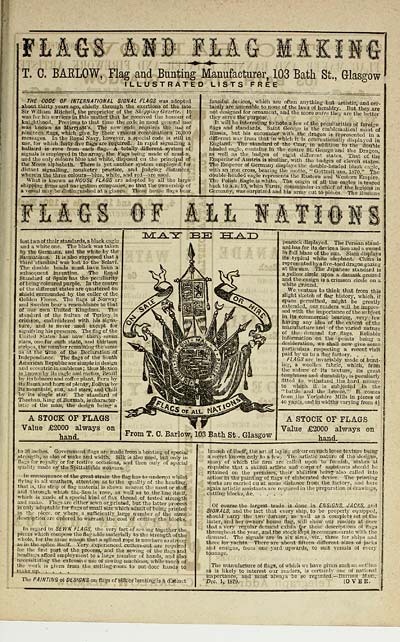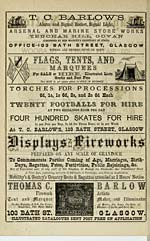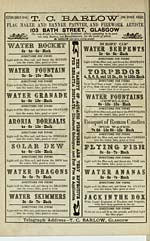Scotland > 1882-1915 - Slater's Royal National Commercial Directory of Scotland > 1886 - Slater's (late Pigot and Co's) Royal national commercial directory and topography of Scotland
(2199)
Download files
Complete book:
Individual page:
Thumbnail gallery: Grid view | List view

T. 0. BARLOW, Flag and Bunting Manufacturer, 103 Bath St., Glasgow
ILLUSTRATED LISTS FREE °
THE CODE OF INTERNATIONAL SIGNAL FLAGS was adopted
about thirty years ago, chiefly through the exertions of the late
Sir William Mitchell, the proprietor of the Shippiny Gazette. It
was for his services in this matter that he received the honour of
knighthood. Previous to that time the code in most general use
was known as Marrjatt's. The new eode requires the uao of
nineteen flags, which give by their vraious combinations 7o',000
messages. In the Royal Navy, however, a special code is still in
use, for which forty-five flags are required. In rapid signalling a
hallaird is rove from each flag. A totally different system of
signals is employed in the army, the Fags being made of musl-n,
and the only colours blue and white, disposed en the principal of
the Morse alphabeth. There is yet another system employed for
distant signalling, musketry practice, and judging distances,
wherein the three colours — blue, white, and red— are used.
What is known as HOUSE FLAGS ara adopted by all the large
shipping firms and navigation companies, so that the ownership of
a vessal may be distinguished at a glance. These house flags bear
fanciful devices, which are often anything but artistic, and cer-
tainly are amenable to none of the laws of heraldry. But they are
not designed for ornament, and the more outre they are the better
they serve the purpose.
It will be interesting to note a few of the peculiarities of foreign
flags and standards. Saint George is the emblematical saint 5 of
Russia, but his encounter with the dragon is represented in a
different way from that in which it is conventionally displayed in
England. The standard of the Czar, in addition to the double
headed eagle, contains in the centre St. George and the Dragon
as well as the badges of eight different states. That of the
Empenor of Austria is similiar, with the badges of eleven states
The Emperor of Germany displays the double-headed blaok eaMe'
with an iron cross, bearing the motto, " Gottmit uns, 1S70 " The
double-headed eagle represents the Eastern and Western Empire
The Polish Eagle is white. The origin of aU the eagles is traced
back to a.d. 10, when Varus, commander- in -chief of the legions in
Germany, was surprized and his array cut to pieces. The Romans
lost two of their standards, a black eagle
and a white one. The black was taken
by the Germans, and the white by the
Sarmatians. It is also supposed that a
third standard was lost to the Sclav!.
The double heads must have been a
subsequent invention. The Royal
Standard of Spain has the peculiarity
of being coloured purple. In the centre
of the different states are quartered on
shield surrounded by the coller of the
Golden Fleece. The flags of Norway
and Sweden bear a resemblance to that
of our own United Kingdom. The
standard of the Sultan of Turkey is
crimson, embroidered with his signa-
ture, and is never used except for
signifying his presence. The flag of the
United States has now thirty-seven
stars, one for each state, and thirteen
stripes, the number remaining the same
as at the time of the Declaration of
Independance. The flags of the South
American Republic are simple in design
and ecceutric in emblems ; thus Mexico
is knownby its eagle and cactus, Brazil
by its tobacco and coffee plant, Peru by
its llama and horn of plenty, Bolivia by
its mountain, sun, and stars, and Chili
by its single star. The standard of
Theebau, King of Burmah, is character-
istic of the man, the design being a
A STOCK OF FLAGS
Value £2000 always on
hand.
-MLJ^TZ: BE JE3LJ±3D
peacock displayed. The Persian stand-
ard has for its device a lion and a sword
in full blaze of the sun. Siam displays
its typical white elephant. China is
represented by a five-toed dragon gazi ng
at the sun. The Japanese standard is
a yellow circle upon a damask ground
and the ensign is a crimson circle oil a
white ground.
We venture to think that from this
slight sketch of flag history, which, if
space permitted, might be greatly
extended, our readers will be impres-
sed with the importance of the subject
in its commercial bearing, very few
having any idea of the extent of the
manufacture and of the varied nature
of the demand for flags. Reliable
information on the points being a
desideration, we shall now give some
particulars respecting a recent visit
paid by us to a flag factory. . . .
FLAGS are invariably made of bunt-
ing, a woollen fabric, which, from
the nature of its texture, its great
toughness and durability, is peculiarly
fltted to withstand the bard usuage
to which it is subjected in the
" battle and the breeze." It comes
from the Yorkshire Mills in pieces of
40 yards, and in widths var3'ing from 4^
From T. C. Barlow, 103 Bath St.. Glasgow
A STOCK OF FLAGS
Value £2000 always on
hand.
to 36 inches. Government flags are made from a bunting of special
strength, as also of make and width. Silk is also used, but only in
flags for royalty or for festive occasions, and then only of special
quality made oy the Spittalfields weavers.
In consequence of the great strain the flag has to undergo whilst
Hying in all weathers, attention as to the quality of theheading,
that is, the strip of flag material is shewn nearest the mast or staff
and through whioh thc-line is rove, as well as to the line itself,
which is made ef a special kind of flax thread of tested strength
and make. Flags are either sewn or.printed, but the latter process
is only adaptable for flags of small size which admit of being printed
in the piece, or where a sufficiently large number of the same
description are ordered to warrant the cost of cutting the .blocks.
In regard to SEWN FLAGS, the very fact of sewing together the
pieces which compose the flag adds materially to the strength of the
whole, for the same reason that a spliced rope is nowhere so strong
as in the splice itself. Very experienced cuttcrs-out arc required
for the first part of the process, and the sewing of the flags and
headings afford emplojonent to a large number of hands, and also
necessitating the extensive use of sewing-machines, while much of
the work is given from the cutting-room to out-door hands to
make up
Die PAINTING of DESIGNS on flags of silk or bunting is a distinct
branch of itself, the art of laying colour on such loose texture being
a seoret known only to a few. The artistic nature of the designs,
many of which the firm are called upon to furnish, makes at
requisite that a skilful artiste and corps of assistants should be
retained on the premises, their abilities being also called into
action in the painting of flags of elaborated device. The printing
works are carried on at some distance from the factory, and here
again artistic assistants are required in the preparation of drawings,
cutting blocks, &c
Of course tbe largest trade is done in ENSIGNS, J A CKS, and
SIGNALS, and tbe fact that every ship, to be properly equipped,
should carry the two former, *aa well as a complete set of the
latter, and her owners* house flag, will show our readers at once
that a very regular demand exists for these descriptions of flags
throughout the year, and the stock kept is commensurate with the
demand. The signals are in six sizes, viz., three for ships and
three for yachts. There are about fifteen different sizes of jacks
and ensigns, from one yard upwards, to suit vessals of every
tonnage.
The manufacture of flags, of which we have given such an outline
as is likely to interest our readers, is certainly one of national
importance, and must always be so regarded.— British Mail,
Bee. 1, 1879. [OVER.
ILLUSTRATED LISTS FREE °
THE CODE OF INTERNATIONAL SIGNAL FLAGS was adopted
about thirty years ago, chiefly through the exertions of the late
Sir William Mitchell, the proprietor of the Shippiny Gazette. It
was for his services in this matter that he received the honour of
knighthood. Previous to that time the code in most general use
was known as Marrjatt's. The new eode requires the uao of
nineteen flags, which give by their vraious combinations 7o',000
messages. In the Royal Navy, however, a special code is still in
use, for which forty-five flags are required. In rapid signalling a
hallaird is rove from each flag. A totally different system of
signals is employed in the army, the Fags being made of musl-n,
and the only colours blue and white, disposed en the principal of
the Morse alphabeth. There is yet another system employed for
distant signalling, musketry practice, and judging distances,
wherein the three colours — blue, white, and red— are used.
What is known as HOUSE FLAGS ara adopted by all the large
shipping firms and navigation companies, so that the ownership of
a vessal may be distinguished at a glance. These house flags bear
fanciful devices, which are often anything but artistic, and cer-
tainly are amenable to none of the laws of heraldry. But they are
not designed for ornament, and the more outre they are the better
they serve the purpose.
It will be interesting to note a few of the peculiarities of foreign
flags and standards. Saint George is the emblematical saint 5 of
Russia, but his encounter with the dragon is represented in a
different way from that in which it is conventionally displayed in
England. The standard of the Czar, in addition to the double
headed eagle, contains in the centre St. George and the Dragon
as well as the badges of eight different states. That of the
Empenor of Austria is similiar, with the badges of eleven states
The Emperor of Germany displays the double-headed blaok eaMe'
with an iron cross, bearing the motto, " Gottmit uns, 1S70 " The
double-headed eagle represents the Eastern and Western Empire
The Polish Eagle is white. The origin of aU the eagles is traced
back to a.d. 10, when Varus, commander- in -chief of the legions in
Germany, was surprized and his array cut to pieces. The Romans
lost two of their standards, a black eagle
and a white one. The black was taken
by the Germans, and the white by the
Sarmatians. It is also supposed that a
third standard was lost to the Sclav!.
The double heads must have been a
subsequent invention. The Royal
Standard of Spain has the peculiarity
of being coloured purple. In the centre
of the different states are quartered on
shield surrounded by the coller of the
Golden Fleece. The flags of Norway
and Sweden bear a resemblance to that
of our own United Kingdom. The
standard of the Sultan of Turkey is
crimson, embroidered with his signa-
ture, and is never used except for
signifying his presence. The flag of the
United States has now thirty-seven
stars, one for each state, and thirteen
stripes, the number remaining the same
as at the time of the Declaration of
Independance. The flags of the South
American Republic are simple in design
and ecceutric in emblems ; thus Mexico
is knownby its eagle and cactus, Brazil
by its tobacco and coffee plant, Peru by
its llama and horn of plenty, Bolivia by
its mountain, sun, and stars, and Chili
by its single star. The standard of
Theebau, King of Burmah, is character-
istic of the man, the design being a
A STOCK OF FLAGS
Value £2000 always on
hand.
-MLJ^TZ: BE JE3LJ±3D
peacock displayed. The Persian stand-
ard has for its device a lion and a sword
in full blaze of the sun. Siam displays
its typical white elephant. China is
represented by a five-toed dragon gazi ng
at the sun. The Japanese standard is
a yellow circle upon a damask ground
and the ensign is a crimson circle oil a
white ground.
We venture to think that from this
slight sketch of flag history, which, if
space permitted, might be greatly
extended, our readers will be impres-
sed with the importance of the subject
in its commercial bearing, very few
having any idea of the extent of the
manufacture and of the varied nature
of the demand for flags. Reliable
information on the points being a
desideration, we shall now give some
particulars respecting a recent visit
paid by us to a flag factory. . . .
FLAGS are invariably made of bunt-
ing, a woollen fabric, which, from
the nature of its texture, its great
toughness and durability, is peculiarly
fltted to withstand the bard usuage
to which it is subjected in the
" battle and the breeze." It comes
from the Yorkshire Mills in pieces of
40 yards, and in widths var3'ing from 4^
From T. C. Barlow, 103 Bath St.. Glasgow
A STOCK OF FLAGS
Value £2000 always on
hand.
to 36 inches. Government flags are made from a bunting of special
strength, as also of make and width. Silk is also used, but only in
flags for royalty or for festive occasions, and then only of special
quality made oy the Spittalfields weavers.
In consequence of the great strain the flag has to undergo whilst
Hying in all weathers, attention as to the quality of theheading,
that is, the strip of flag material is shewn nearest the mast or staff
and through whioh thc-line is rove, as well as to the line itself,
which is made ef a special kind of flax thread of tested strength
and make. Flags are either sewn or.printed, but the latter process
is only adaptable for flags of small size which admit of being printed
in the piece, or where a sufficiently large number of the same
description are ordered to warrant the cost of cutting the .blocks.
In regard to SEWN FLAGS, the very fact of sewing together the
pieces which compose the flag adds materially to the strength of the
whole, for the same reason that a spliced rope is nowhere so strong
as in the splice itself. Very experienced cuttcrs-out arc required
for the first part of the process, and the sewing of the flags and
headings afford emplojonent to a large number of hands, and also
necessitating the extensive use of sewing-machines, while much of
the work is given from the cutting-room to out-door hands to
make up
Die PAINTING of DESIGNS on flags of silk or bunting is a distinct
branch of itself, the art of laying colour on such loose texture being
a seoret known only to a few. The artistic nature of the designs,
many of which the firm are called upon to furnish, makes at
requisite that a skilful artiste and corps of assistants should be
retained on the premises, their abilities being also called into
action in the painting of flags of elaborated device. The printing
works are carried on at some distance from the factory, and here
again artistic assistants are required in the preparation of drawings,
cutting blocks, &c
Of course tbe largest trade is done in ENSIGNS, J A CKS, and
SIGNALS, and tbe fact that every ship, to be properly equipped,
should carry the two former, *aa well as a complete set of the
latter, and her owners* house flag, will show our readers at once
that a very regular demand exists for these descriptions of flags
throughout the year, and the stock kept is commensurate with the
demand. The signals are in six sizes, viz., three for ships and
three for yachts. There are about fifteen different sizes of jacks
and ensigns, from one yard upwards, to suit vessals of every
tonnage.
The manufacture of flags, of which we have given such an outline
as is likely to interest our readers, is certainly one of national
importance, and must always be so regarded.— British Mail,
Bee. 1, 1879. [OVER.
Set display mode to: Large image | Transcription
Images and transcriptions on this page, including medium image downloads, may be used under the Creative Commons Attribution 4.0 International Licence unless otherwise stated. ![]()
| Permanent URL | https://digital.nls.uk/90669812 |
|---|
| Description | Directories of the whole, or large parts of, Scotland. |
|---|
| Description | Around 700 Scottish directories published annually by the Post Office or private publishers between 1773 and 1911. Most of Scotland covered, with a focus on Edinburgh, Glasgow, Dundee and Aberdeen. Most volumes include a general directory (A-Z by surname), street directory (A-Z by street) and trade directory (A-Z by trade). |
|---|


